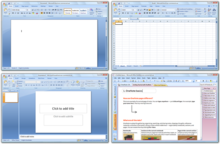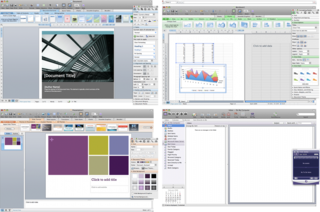 | |
 Microsoft Office 2007 applications shown on Windows Vista – clockwise from top left: Word, Excel, OneNote and PowerPoint. These four programs make up the Home and Student edition. | |
| Developer(s) | Microsoft |
|---|---|
| Initial release | January 30, 2007 [1] |
| Final release | Service Pack 3 (12.0.6612.1000) [2] / October 25, 2011 |
| Operating system |
|
| Platform | IA-32 [3] |
| Predecessor | Microsoft Office 2003 (2003) |
| Successor | Microsoft Office 2010 (2010) |
| Available in | English, Arabic, Simplified Chinese, Traditional Chinese, Czech, Danish, Dutch, Estonian, Finnish, French, German, Greek, Hebrew, Hindi, Hungarian, Italian, Japanese, Korean, Latvian, Lithuanian, Norwegian (Bokmål), Polish, Portuguese, Romanian, Russian, Slovak, Slovenian, Spanish, Swedish, Thai, Turkish, and Ukrainian. [4] |
| Type | Office suite |
| License | Trialware |
| Website | products |
Microsoft Office 2007 (codenamed Office 12 [5] ) is an office suite for Windows, developed and published by Microsoft. It was officially revealed on March 9, 2006 and was the 12th version of Microsoft Office. It was released to manufacturing on November 3, 2006; [6] it was subsequently made available to volume license customers on November 30, 2006, [7] [8] and later to retail on January 30, 2007, [1] shortly after the completion of Windows Vista. The ninth major release of Office for Windows, Office 2007 was preceded by Office 2003 and succeeded by Office 2010. The Mac OS X equivalent, Microsoft Office 2008 for Mac, was released on January 15, 2008.
Contents
- Development
- Service packs
- Editions
- Volume licensing
- New features
- User interface
- SmartArt
- File formats
- Metadata
- User assistance system
- Collaboration features
- Themes and Quick Styles
- Application-specific changes
- Word
- Outlook
- Excel
- PowerPoint
- OneNote
- Access
- Publisher
- InfoPath
- Visio
- Project
- SharePoint Designer
- Server components
- SharePoint Server 2007
- Forms Server 2007
- Groove Server 2007
- Project Server 2007
- Project Portfolio Server 2007
- PerformancePoint Server 2007
- Removed features
- Criticism
- Redesigned user interface
- Office Open XML 2
- Bibliographies
- See also
- References
Office 2007 introduced a new graphical user interface called the Fluent User Interface, which uses ribbons and an Office menu instead of menu bars and toolbars. [9] Office 2007 also introduced Office Open XML file formats as the default file formats in Excel, PowerPoint, and Word. The new formats are intended to facilitate the sharing of information between programs, improve security, reduce the size of documents, and enable new recovery scenarios. [10]
Office 2007 is incompatible with Windows 2000 and earlier versions of Windows. Office 2007 is compatible with Windows XP SP2 or later, Windows Server 2003 SP1 or later, Windows Vista, Windows Server 2008, Windows 7, Windows Server 2008 R2, Windows 8, Windows Server 2012, Windows 8.1, Windows Server 2012 R2 and Windows 10 until version 1607. [3] It is the last version of Microsoft Office to support the 64-bit versions of Windows XP and Windows Server 2003, the 32-bit versions of Windows XP SP2, Windows Server 2003 SP1, and Windows Vista RTM as the following version, Microsoft Office 2010 only supports Windows XP SP3, Windows Server 2003 SP2, and Windows Vista SP1 or later. It is officially unsupported on Windows 10 version 1703 or later, Windows 11, Windows Server 2019, Windows Server 2022. [11]
Office 2007 includes new applications and server-side tools, including Microsoft Office Groove, a collaboration and communication suite for smaller businesses, which was originally developed by Groove Networks before being acquired by Microsoft in 2005. Also included is SharePoint Server 2007, a major revision to the server platform for Office applications, which supports Excel Services, a client-server architecture for supporting Excel workbooks that are shared in real time between multiple machines, and are also viewable and editable through a web page.
With Microsoft FrontPage discontinued, Microsoft SharePoint Designer, which is aimed towards development of SharePoint portals, becomes part of the Office 2007 family. Its designer-oriented counterpart, Microsoft Expression Web, is targeted for general web development. However, neither application has been included in Office 2007 software suites.
Speech recognition functionality has been removed from the individual programs in the Office 2007 suite, as Windows Speech Recognition was integrated into Windows Vista. Windows XP users must install a previous version of Office to use speech recognition features. [12]
According to Forrester Research, as of May 2010, Microsoft Office 2007 is used in 81% of enterprises it surveyed (its sample comprising 115 North American and European enterprise and SMB decision makers). [13]
Mainstream support for Office 2007 ended on October 9, 2012, and extended support ended on October 10, 2017. [14] On August 27, 2021, Microsoft announced that Outlook 2007 and Outlook 2010 would be cut off from connecting to Microsoft 365 Exchange servers on November 1, 2021. [15]















